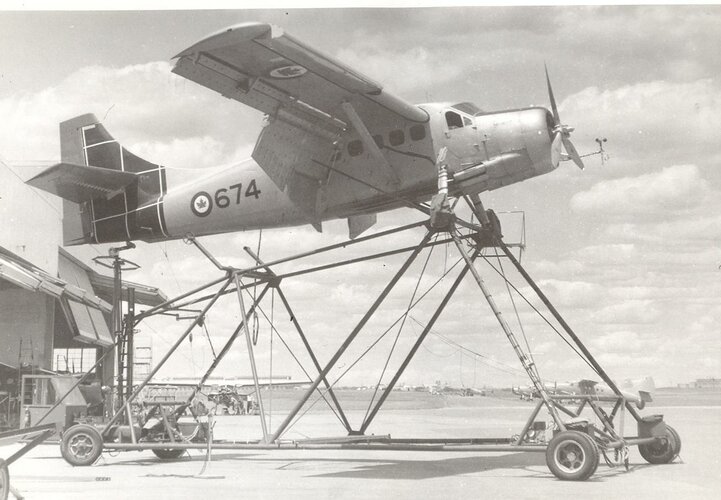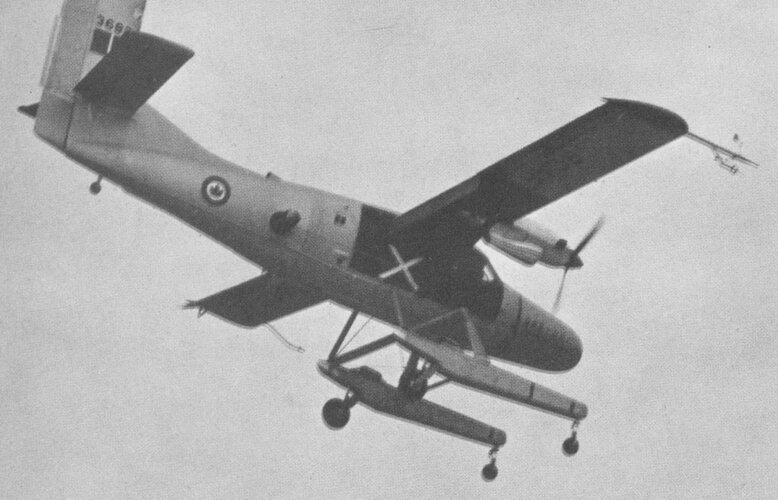jackssmirkingrevenge
ACCESS: Restricted
- Joined
- 5 July 2023
- Messages
- 19
- Reaction score
- 69
The most interesting and fruitful project was a programme, funded by the Defence Research Board that had four experimental phases to investigate the effects on airfield performance of lift produced by propeller slipstream deflection, controllable, jet drag and thrust, and the pilot’s ability to cope with what might turn out to be extremely short field performance.
In the first phase an Otter was mounted on a high cradle on a test rig, similar to an earlier Caribou model test arrangement. The aircraft was mounted high enough to be largely out of ground effect, and was driven down the runway with its engine running, and measurements were taken. In the second phase still larger flaps were installed (“Batwing”), the empennage was redesigned and enlarged, and a sturdier landing gear with double the energy absorption capacity was installed. Flight tests were conducted and measurements taken. In the third phase, the standard flaps were re-installed, with modifications, and a General Electric J-85 jet engine was installed in the cabin in a steel “doghouse”. Air was supplied through a duct from an intake on the cabin roof. A tee-shaped jet pipe discharged out each side of the fuselage, aft of the cabin doors. Coupled rotating jet nozzles were controlled hydraulically (by the pilot) to modulate the jet efflux direction from full forward to full aft. A prototype Caribou nose wheel actuator and an electric power pack were utilized. The efflux direction was controlled by a lever beside the pilot’s seat. The lever mounted a twist grip to control the J-85 engine speed and hence thrust magnitude. The necessary additional engine instruments, fuel system, etc were installed. Again, the flight testing was successfully completed.
At about this time, Pratt & Whitney Canada (PWC) engaged deHavilland to install their new turboprop engine, the PT-6, in the nose of a Beechcraft Expeditor, and conduct limited and preliminary flight trials. deHavilland liked the engine very much and this led to a long association with PWC for the supply of engines to power dehavilland / Bombardier aircraft, which exists to present times. In the fourth and final phase of the experimental Otter programme the R1340 engine was removed and replaced with two wing-mounted PT6A-4 engines. In this final configuration, landing performance was spectacular. The aircraft could approach at 3 to 4 times the steepness of a conventional technique, and land over the 50 foot screen in under 500 feet.


In the first phase an Otter was mounted on a high cradle on a test rig, similar to an earlier Caribou model test arrangement. The aircraft was mounted high enough to be largely out of ground effect, and was driven down the runway with its engine running, and measurements were taken. In the second phase still larger flaps were installed (“Batwing”), the empennage was redesigned and enlarged, and a sturdier landing gear with double the energy absorption capacity was installed. Flight tests were conducted and measurements taken. In the third phase, the standard flaps were re-installed, with modifications, and a General Electric J-85 jet engine was installed in the cabin in a steel “doghouse”. Air was supplied through a duct from an intake on the cabin roof. A tee-shaped jet pipe discharged out each side of the fuselage, aft of the cabin doors. Coupled rotating jet nozzles were controlled hydraulically (by the pilot) to modulate the jet efflux direction from full forward to full aft. A prototype Caribou nose wheel actuator and an electric power pack were utilized. The efflux direction was controlled by a lever beside the pilot’s seat. The lever mounted a twist grip to control the J-85 engine speed and hence thrust magnitude. The necessary additional engine instruments, fuel system, etc were installed. Again, the flight testing was successfully completed.
At about this time, Pratt & Whitney Canada (PWC) engaged deHavilland to install their new turboprop engine, the PT-6, in the nose of a Beechcraft Expeditor, and conduct limited and preliminary flight trials. deHavilland liked the engine very much and this led to a long association with PWC for the supply of engines to power dehavilland / Bombardier aircraft, which exists to present times. In the fourth and final phase of the experimental Otter programme the R1340 engine was removed and replaced with two wing-mounted PT6A-4 engines. In this final configuration, landing performance was spectacular. The aircraft could approach at 3 to 4 times the steepness of a conventional technique, and land over the 50 foot screen in under 500 feet.


